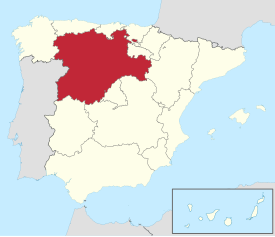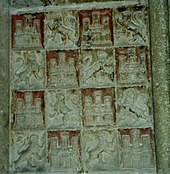Castile and León | |
|---|---|
 Location of Castile and León within Spain | |
| Coordinates: 41°38′42″N 04°44′33″WCoordinates: 41°38′42″N 04°44′33″W | |
| Country | |
| Capital | Valladolid (de facto)[1] |
| Provinces | Ávila, Burgos, León, Palencia, Salamanca, Segovia, Soria, Valladolid and Zamora |
| Government | |
| • President | Alfonso Fernández Mañueco (PP) |
| • Legislature | Cortes of Castile and León |
| • Executive | Junta of Castile and León |
| Area | |
| • Total | 94,222 km2 (36,379 sq mi) |
| • Rank | 1st (18.6% of Spain) |
| Population (2016) | |
| • Total | 2,447,519 |
| • Density | 26/km2 (67/sq mi) |
| • Pop. rank | 6th |
| • Percent | 5.42% of Spain |
| Demonyms |
|
| GDP (nominal; 2018) | |
| • Per capita | €24,397 |
| ISO 3166 code | ES-CL |
| Official languages | Spanish |
| Statute of Autonomy | March 2, 1983 |
| Congress seats | 31 (of 350) |
| Senate seats | 39 (of 265) |
| HDI (2019) | 0.909[3] very high · 7th |
| Website | jcyl.es |
Castile and León (Spanish: Castilla y León [kasˈtiʎa i leˈon] (![]() listen); Leonese: Castiella y Llión [kasˈtjeʎa i ʎiˈoŋ]; Galician: Castela e León [kasˈtɛlɐ ɪ leˈoŋ]) is an autonomous community in northwestern Spain.
listen); Leonese: Castiella y Llión [kasˈtjeʎa i ʎiˈoŋ]; Galician: Castela e León [kasˈtɛlɐ ɪ leˈoŋ]) is an autonomous community in northwestern Spain.
It was created in 1983 by the merging of the provinces of the historic region of León: León, Zamora and Salamanca with those of Castilla La Vieja (Old Castile): Ávila, Burgos, Palencia, Segovia, Soria and Valladolid. The provinces of Santander and Logroño, which until then had been included in the Old Castile administrative division, opted out of this merger[4] and formed the new Autonomous Communities of Cantabria and La Rioja respectively.
Castile and León is the largest autonomous community in Spain in terms of area, covering 94,222 km2. It is however sparsely populated, with a population density below 30/km2. While a capital has not been explicitly declared, the seats of the executive and legislative powers are set in Valladolid by law and for all purposes that city (also the most populated municipality) serves as de facto regional capital.
Castile and León is a landlocked region, bordered by Portugal as well as by the Spanish autonomous communities of Galicia, Asturias, Cantabria, the Basque Country, La Rioja, Aragon, Castilla–La Mancha, the Community of Madrid and Extremadura. Chiefly comprising the northern half of the Inner Plateau, it is surrounded by mountain barriers (the Cantabrian Mountains to the North, the Sistema Central to the South and the Sistema Ibérico to the East) and most of the territory is drained by the Douro River (Spanish: Duero), flowing west toward the Atlantic Ocean.
The region contains eleven World Heritage Sites, making it (along with Lombardia in Italy) the region with most UNESCO World Heritage Sites. UNESCO recognizes the Cortes of León of 1188 as the cradle of worldwide parliamentarism.[5]
Symbols[edit]
The Statute of Autonomy of Castile and León, reformed for the last time in 2007, establishes in the sixth article of its preliminary title the symbols of the community's exclusive identity. These are: the coat of arms, the flag, the banner and the anthem. Its legal protection is the same as that corresponding to the symbols of the State -whose outrages are classified as crime in article 543 of the Penal Code-.[6]
In the articulated statuary, the coat of arms is defined as follows:[6]
Likewise, the flag is described as follows:[6]
Following the same wording, the banner is constituted by the shield quartered on a traditional crimson background. The Statute also expresses: "The anthem and the other symbols [...] will be regulated by specific law". After the promulgation of the fundamental norm, this law was not promulgated, so the anthem does not exist, but de iure is a symbol of autonomy.[6]
You received this message because you are subscribed to the Google Groups "1top-oldtattoo-2" group.
To unsubscribe from this group and stop receiving emails from it, send an email to 1top-oldtattoo-2+unsubscribe@googlegroups.com.
To view this discussion on the web visit https://groups.google.com/d/msgid/1top-oldtattoo-2/CAHT58898K6NYst2M4MXa%3DbHiqoVPCR8gjbp6iG9Em6z8FdG08w%40mail.gmail.com.







No comments:
Post a Comment